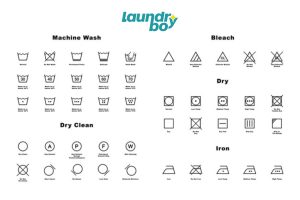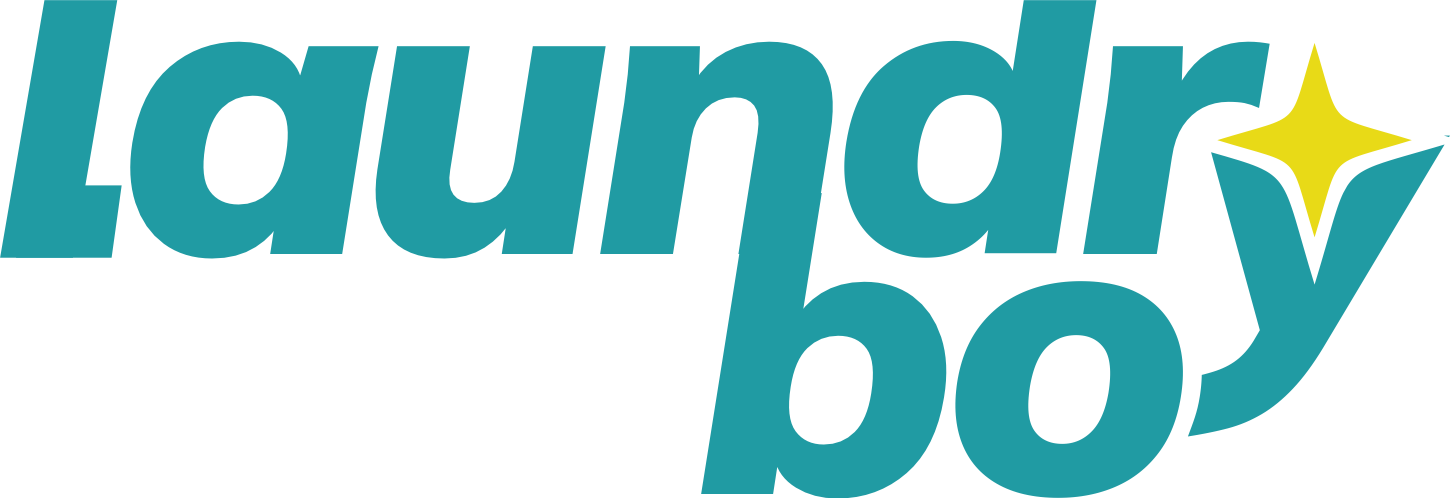Not all types of fabric should be washed the same way. For example, you might buy a pricey cashmere sweater, wash it twice, and notice it falling apart, leaving you wondering what went wrong.
Most clothing brands add product tags or labels to prevent such issues. These tags give instructions about the type of water, the washing method, and how long the fabric should be handled during washing.
And we get it—those symbols are quite tricky to understand at the first look. That’s why we created this article.
Here, you’ll find all the common laundry symbols and their meanings. With this knowledge, you can avoid ruining delicate fabrics or damaging your valuable outfits.
In This Article
Laundry Symbols: Key Takeaways
- Laundry symbols are care symbols that guide us on properly washing our clothes for long-lasting care.
- You can find these tags inside the cloth, not outside.
- The symbols are indicated as icons. The categories are dry cleaning, ironing, drying, hand washing, synthetic washing, and bleaching.
- It’s easier to read and decode these symbols by the object icon and note the little alterations made to those icons.
At Laundry Boy, we pay close attention to these symbols during sorting to decide the best washing method for each type of clothing. If you’re in a hurry, you can use the chart below for a quick overview of these symbols, their meanings, and how to identify them.

What Type of Clothes Come With Laundry Symbols?
Laundry symbols are found on most clothing. They vary from your everyday tee to delicate fabrics like silk and wool. In some shirts and pants, they may not appear visible. So, it also depends on where you look at.
These care labels are often placed in the following areas:
- Inside the neckline for tops and dresses
- Alongside inner seams for pants and skirts
- Near the waistbands for undergarments and leisure wear
Laundry symbols are essentially care symbols that indicate your fabric method of washing, ironing, or dry cleaning. Manufacturers usually put these symbols on clothing to ensure clothes last longer for their customers.
You are careful to check the laundry symbols on your clothes on your next wash day for lasting use to avoid shrinkage, fading, or even ruining your favorite garments.
All Laundry Symbols Explained
Let’s begin with the popular one, which is dry cleaning.
Dry Cleaning Symbols
Dry Cleaning is a professional service that can damage your clothes if not done properly. It is preferable to leave clothes you find with drycleaning symbols to avoid spoiling or damaging them. They indicate how a cloth should be cleaned.
- The DO NOT DRY CLEAN symbol is a circle crossed out with an “X” mark. It means they can be easily damaged when dry cleaning.
- The dry cleaning symbol you find with a circle and “A” means that you can use any solvent to clean the fabric.
- The circle with “P” means you can use any solvent except for solvents with trichloroethylene [a colorless chemical with a cholorflom odor].
- When you find “F” inside a circle, it means using a petroleum-based solvent would be advisable for washing the fabric you can’t dry clean.
Ironing Symbols
Ironing is a great way to remove wrinkles and give your garments a crisp, polished look.
However, not all fabrics can handle the heat or pressure of an iron. That’s where ironing symbols come in—they’re shaped like a small iron and provide crucial guidance on how to care for your clothes safely.
These symbols indicate whether ironing suits the garment and, if so, the appropriate temperature and settings to use. By following these instructions, you can maintain the quality and appearance of your clothes while avoiding damage caused by improper care.
- Iron icon with one dot: Cool iron (up to 110°C). Suitable for delicate fabrics like polyester or silk.
- Iron icon with two dots: Warm iron (up to 150°C). For fabrics like cotton blends.
- Iron icon with three dots: Hot iron (up to 200°C). For sturdy fabrics like linen or denim.
- Iron icon with steam lines: Steam ironing is safe.
- Iron with an “X”: Do not iron.
QUICK TIP:
- This is often for materials like plastic prints or delicate embellishments.
Drying Symbols
Laundry symbols don’t just guide you on washing—they also tell you how to dry your clothes properly.
The first step is determining whether the garment should be air-dried or tumble-dried. The lines inside a square indicate the appropriate air-drying method, while the presence of a circle inside a square signifies tumble drying.
If tumble drying is allowed, the symbol will also specify how to do it:
- Underscored lines indicate the cycle type (delicate, gentle, or regular).
- Black dots represent the recommended temperature settings.
- An X over the symbol means tumble drying is unsafe for the item.
Air drying is a delicate method that preserves fabric quality and prevents shrinkage. Specific air-drying symbols guide you on the best practices.
- Drip Dry: This is represented by a square with three vertical lines. This symbol means you should hang the wet garment and let it dry naturally without wringing or twisting. This method is ideal for delicate fabrics that may lose shape if handled roughly.
- Dry in the Shade: This symbol, typically a square with an arc (representing the sun) crossed by a line, indicates that the garment should dry away from direct sunlight. It helps prevent fading and protects sensitive fabrics from UV damage.
- Hang Dry: A square with a curved line at the top, which shows that the garment should be hung on a clothesline or hanger to dry. This is great for items like activewear or denim, which might lose shape if laid flat.
- Dry Flat: This is shown by a square with a horizontal line inside; this symbol suggests laying the item flat on a clean surface to dry. It’s often recommended for knitwear and other delicate fabrics that can stretch out when hung.
Hand Washing Symbols
Hand-washing symbols instruct you on how exactly to wash a garment. They are usually easy to spot and depicted with a hand above them. When you spot the hand washing symbol, it is advisable not to use a washing machine to wash it. Rather, use your hand or wash it in a tub or bowl. Delicate fabrics like silk, wool, and lace require hand washing.
- Bucket with a hand inside: Hand wash only. Fill a basin with lukewarm water, use a mild detergent, and gently massage the fabric.
- Bucket with no hand but a number: If hand washing isn’t specified, the number represents the maximum water temperature for safe washing.
- Bucket with an X: Do not wash at home. These items require dry cleaning or professional care.
Synthetic Washing Symbols
Synthetic items often require more specific care to stay in shape.
The washing symbol for synthetic fabrics is a line drawn over a bucket. The bucket indicates the washing item is washable. Synthetic washing symbols include the following:
- Bucket with one dot: Wash synthetic in cold water (around 30°C). It is ideal for polyester and blends similar to polyester.
- Bucket with two dots: Wash in warm water (around 40°C). Safe for slightly more durable synthetics.
- Bucket with a line underneath: Use a gentle or permanent press cycle to prevent wrinkles or damage.
- Bucket with two lines underneath: Opt for a very delicate cycle, suitable for thin or stretchy synthetic fabrics like spandex.
- Bucket with an X: Do not machine wash. Hand washing or professional cleaning is required.
Bleaching Symbols
To decide whether to use bleach or not, it is important to check your garment fabric label, which is indicated by a triangle or a do not bleach symbol.
- Empty triangle: Any bleach can be used, including chlorine-based ones.
- Triangle with two diagonal lines: Use only a non-chlorine bleach.
- Triangle with an X: Do not bleach. Opt for alternative stain removal methods like baking soda or not bleaching.
How To Read Any Care Label Symbol
Care labels are not difficult if you take your time to understand them.
They are among the universal laundry languages, just like we have universal languages in medicine and art fields.
The Federal Trade Commission came up with a care label rule to make sure consumers gave their clothing items the proper care the clothes deserved.
They are also used to avoid lengthy explanations on clothes for easier understanding.
- Washing: Look for the bucket icon to see how to clean your clothes (machine, hand wash, or avoid washing).
- Drying: A square icon guides how to dry clothes—whether to tumble, drip, or lay flat.
- Ironing: The iron symbol means the amount of temperature that can be applied to the clothes and whether steam can be used or not.
- Bleaching: Triangles show whether bleach is allowed or not.
- Dry Cleaning: Circles explain if professional cleaning is needed and what solvents can be used.
Laundry symbols are your clothes guide to longevity.
At Laundry Boy, we meticulously follow the care labels we find on clothing items, so we provided this comprehensive guide for easy explanation. That’s one of the benefit of using a laundry service instead of stressing yourself.
Do you still have a laundry symbol you don’t understand? Give us a comment, and we will definitely respond!


One thought on “Laundry Symbols Meaning: Care Labels Explained (With chart)”